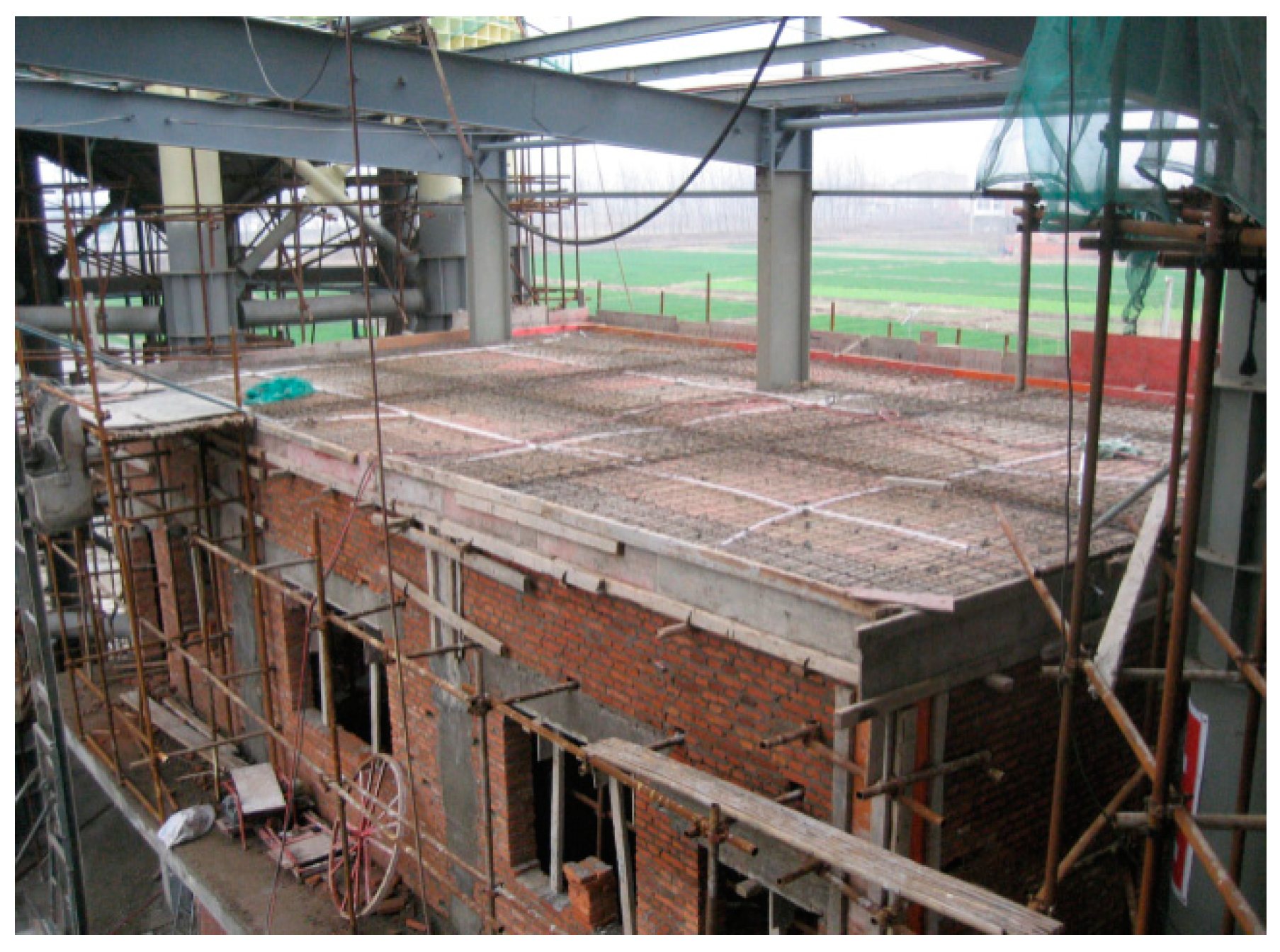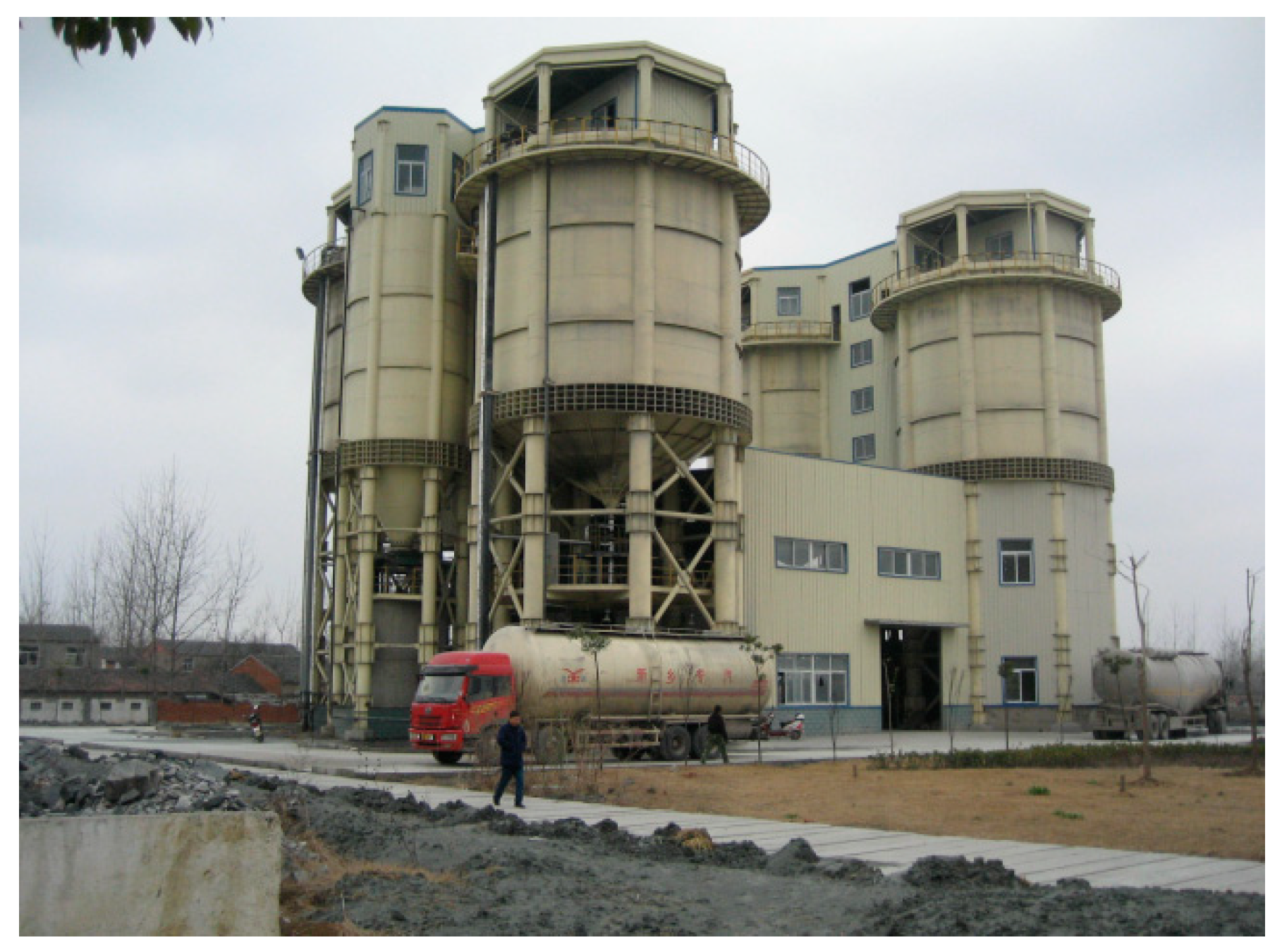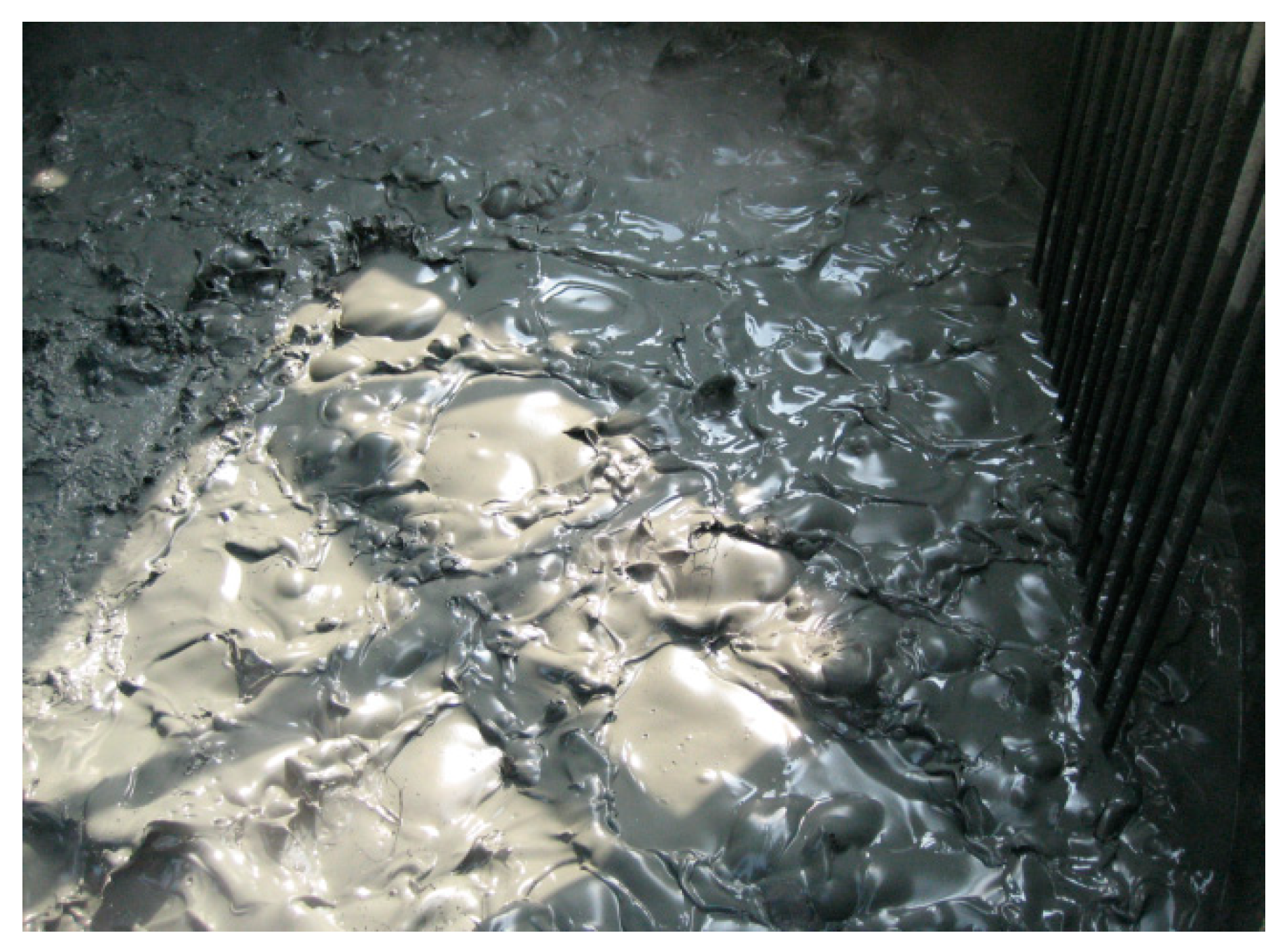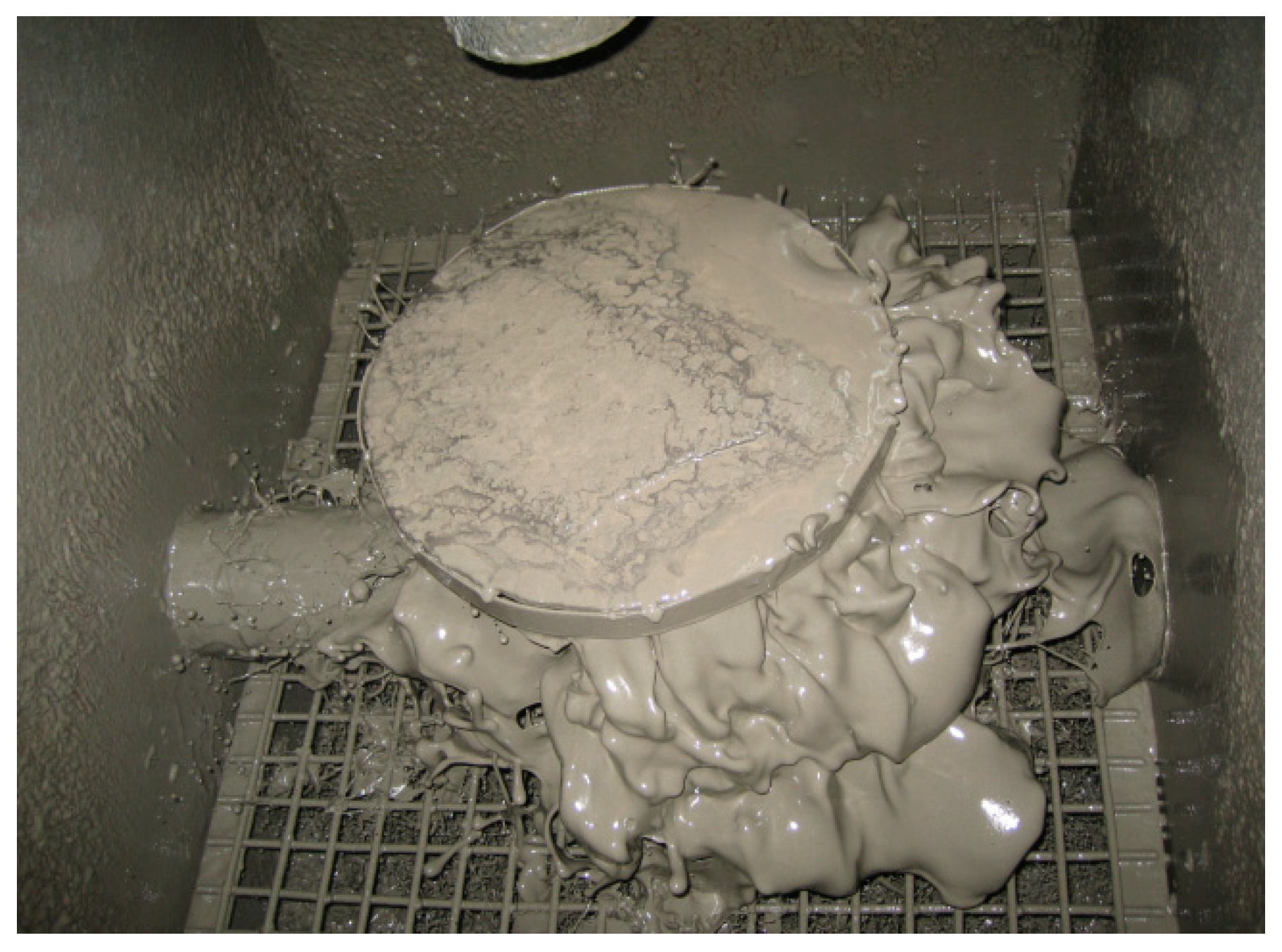Analysis and Improvement of Oversize Goaf Backfill Engineering Based on Fuzzy Theory
Abstract
:1. Introduction
2. Backfill Engineering and System Operation
2.1. Overview of Mine
2.2. Construction of Backfill Preparation System
2.3. Operation of Backfill System
3. Fuzzy Analysis of Backfill Quality
3.1. Backfill Conditions of Goaf
3.2. Fuzzy Analysis of the Backfill Quality
3.3. Measures to Improve Backfill Quality
4. Conclusions
Author Contributions
Funding
Data Availability Statement
Acknowledgments
Conflicts of Interest
References
- Al-Moselly, Z.; Fall, M.; Haruna, S. Further insight into the strength development of cemented paste backfill materials containing polycarboxylate ether-based superplasticizer. J. Build. Eng. 2022, 47, 103859. [Google Scholar] [CrossRef]
- Li, J.; Cao, S.; Yilmaz, E.; Liu, Y. Compressive fatigue behavior and failure evolution of additive fiber-reinforced cemented tailings composites. Int. J. Miner. Metall. Mater. 2022, 29, 345–355. [Google Scholar] [CrossRef]
- Petlovanyi, M.V.; Zubko, S.A.; Popovych, V.V.; Sai, K.S. Physicochemical mechanism of structure formation and strengthening in the backfill massif when filling underground cavities. Vopr. Khimii I Khimicheskoi Tekhnologii 2020, 6, 142–150. [Google Scholar]
- Kongarsyuryun, C.; Ubysz, A.; Faradzhov, V. Models and algorithms of choice of development technology of deposits when selecting the composition of the backfilling mixture. IOP Conf. Ser. Earth Environ. Sci. 2021, 684, 012008. [Google Scholar] [CrossRef]
- Khayrutdinov, M.M.; Golik, V.I.; Aleksakhin, A.V.; Trushina, E.V.; Lazareva, N.V.; Aleksakhina, Y.V. Proposal of an algorithm for choice of a development system for operational and environmental safety in mining. Resources 2022, 11, 88. [Google Scholar] [CrossRef]
- Ermolovich, E.A.; Ivannikov, A.L.; Khayrutdinov, M.M.; Kongar-Syuryun, C.B.; Tyulyaeva, Y.S. Creation of a nanomodified backfill based on the waste from enrichment of water-soluble ores. Materials 2022, 15, 3689. [Google Scholar] [CrossRef] [PubMed]
- Kongar-Syuryun, C.; Aleksakhin, A.; Khayrutdinov, A.; Tyulyaeva, Y. Research of rheological characteristics of the mixture as a way to create a new backfill material with specified characteristics. Mater. Today Proc. 2021, 38, 2052–2054. [Google Scholar] [CrossRef]
- Wang, M.; Shi, X.; Zhou, J.; Qiu, X. Multi-planar detection optimization algorithm for the interval charging structure of large-diameter longhole blasting design based on rock fragmentation aspects. Eng. Optim. 2018, 50, 2177–2191. [Google Scholar] [CrossRef]
- Wang, Q.; Zhao, Y. Application of VCR mining method in steeply inclined thin ore body of a gold mine. Mod. Min. 2019, 35, 265–266. [Google Scholar]
- Xiao, S.; Wang, H.; Dong, G. A preliminary study on the design method for large-diameter deep-hole presplit blasting and its vibration-isolation effect. Shock Vib. 2019, 2019, 2038578. [Google Scholar] [CrossRef]
- Huang, X. Study on Controlled Blasting Technology in Deep Stope of Zijinshan Gold and Copper Mine; Fuzhou University: Fuzhou, China, 2018. [Google Scholar]
- Dong, S. Optimization scheme of the mining technique of isolation ore pillars of Dongguashan deposit. Met. Mine 2022, 51, 107–112. [Google Scholar]
- Chen, X.; Yang, X.; Guo, L.; Xu, W.; Shi, C. Intelligent control system design on mine filling and engineering applications. Nonferrous Met. 2022, 12, 114–120. [Google Scholar]
- Lv, S.; Shi, C. Application of the ashele copper filling automation control system. China Min. Mag. 2018, 27 (Suppl. S1), 226–231. [Google Scholar]
- Wang, Z.; Zhou, Y.; Yao, Y. Research on process optimization of mobile pumping filling system in underground of metal mine. Hunan Nonferrous Met. 2018, 34, 7–9. [Google Scholar]
- Yang, Q.; Wang, Y.; Wang, Y.; Han, Z.; Wang, Z. Application and benefits analysis of paste filling key technologies in Chambishi copper mine. Mod. Min. 2018, 34, 25–28. [Google Scholar]
- Zhang, H.; Wang, Z. Renovation and application of filling system in Jinfeng Gold Mine. Gold 2018, 39, 36–41. [Google Scholar]
- Mo, D.; Liu, X.; Wang, C. Expansive capability reform and application of the full tailings paste filling system in Wancheng mining industry. Min. Res. Dev. 2018, 38, 11–15. [Google Scholar]
- Hou, L.; Yang, Z.; Han, J. The research of the system of filling system of Hongtoushan mine. Non-Ferr. Min. Metall. 2017, 33, 15–17. [Google Scholar]
- Saedi, A.; Ahmad, J.Z.; Darban, A.K. A review on different methods of activating tailings to improve their cementitious property as cemented paste and reusability. J. Environ. Manag. 2020, 270, 110881. [Google Scholar] [CrossRef]
- Chen, Q.; Luo, K.; Wang, Y.; Li, X.; Zhang, Q.; Liu, Y. In-situ stabilization/solidification of lead/zinc mine tailings by cemented paste backfill modified with low-carbon bentonite alternative. J. Mater. Res. Technol. 2022, 17, 1200–1210. [Google Scholar] [CrossRef]
- Zhang, Q.L.; Li, Y.T.; Chen, Q.S.; Liu, Y.K.; Feng, Y.; Wang, D.L. Effects of temperatures and pH values on rheological properties of cemented paste backfill. J. Cent. South Univ. 2021, 28, 1707–1723. [Google Scholar] [CrossRef]
- Akkaya, U.G.; Cinku, K.; Yilmaz, E. Characterization of strength and quality of cemented mine backfill made up of lead-zinc processing tailings. Front. Mater. 2021, 8, 740116. [Google Scholar] [CrossRef]
- Cihangir, F.; Ercikdi, B.; Kesimal, A.; Deveci, H.; Erdemir, F. Paste backfill of high-sulphide mill tailings using alkali-activated blast furnace slag: Effect of activator nature, concentration and slag properties. Miner. Eng. 2015, 83, 117–127. [Google Scholar] [CrossRef]
- Petlovanyi, M.; Mamaikin, O. Assessment of an expediency of binder material mechanical activation in cemented rockfill. ARPN J. Eng. Appl. Sci. 2019, 14, 3492–3503. [Google Scholar]
- Qi, C.; Fourie, A.; Chen, Q. Neural network and particle swarm optimization for predicting the unconfined compressive strength of cemented paste backfill. Constr. Build. Mater. 2018, 159, 473–478. [Google Scholar] [CrossRef]
- Lang, L.; Song, K.I.; Lao, D.; Kwon, T.H. Rheological Properties of Cemented Tailing Backfill and the Construction of a Prediction Model. Materials 2015, 8, 2076–2092. [Google Scholar] [CrossRef]
- Chen, Q.; Tao, Y.; Zhang, Q.; Qi, C. The rheological, mechanical and heavy metal leaching properties of cemented paste backfill under the influence of anionic polyacrylamide. Chemosphere 2022, 286, 131630. [Google Scholar] [CrossRef]
- Xiao, P. One-time blasting cutting well and deep hole technology in deep hole slot area of Caolu Iron mine. Mod. Min. 2021, 37, 87–88. [Google Scholar]
- Ma, W.; Zhang, S. Application of vertical deep hole drop stage mining room (VCR) method in Caolou Iron Mine. Mod. Min. 2010, 26, 93–96. [Google Scholar]
- Deng, D.; Jiang, N.; Duan, Y. Sampling and mechanical testing of backfill in large mined-out area. Geofluids 2021, 2021, 6686385. [Google Scholar] [CrossRef]
- Tang, Y.; Tan, S.; Zhou, D. An Improved Failure Mode and Effects Analysis Method Using Belief Jensen–Shannon Divergence and Entropy Measure in the Evidence Theory. Arab. J. Sci. Eng. 2022, 48, 7163–7176. [Google Scholar] [CrossRef]
- Tang, Y.; Chen, Y.; Zhou, D. Measuring Uncertainty in the Negation Evidence for Multi-Source Information Fusion. Entropy 2022, 24, 1596. [Google Scholar] [CrossRef] [PubMed]
- Hajghasem, M.; Abtahi, A.R.; Khalili-Damghani, K.; Yousefi-Zenouz, R. Selecting the Optimal LoA to Prevent the Expansion of COVID-19 in the Chemical Industry considering Sustainability Factors: A Fuzzy Mathematical Optimization Approach. Discret. Dyn. Nat. Soc. 2022, 2022, 5836663. [Google Scholar] [CrossRef]
- Alawad, H.; An, M.; Kaewunruen, S. Utilizing an Adaptive Neuro-Fuzzy Inference System (ANFIS) for Overcrowding Level Risk Assessment in Railway Stations. Appl. Sci. 2020, 10, 5156. [Google Scholar] [CrossRef]
- Sirisha, A.B.; AV DS, R.; Ram, T.P. A hybrid approach consisting of multi-objective and multivariate analyses for WAAM specimens. Eng. Res. Express 2023, 5, 025006. [Google Scholar]
- Osman, M.S.; Abo-Sinna, M.A.; Mousa, A.A. A combined genetic algorithm-fuzzy logic controller (GA–FLC) in nonlinear programming. Appl. Math. Comput. 2005, 170, 821–840. [Google Scholar] [CrossRef]
- Dindar, S.; Kaewunruen, S.; An, M. Bayesian network-based human error reliability assessment of derailments. Reliab. Eng. Syst. Saf. 2020, 197, 106825. [Google Scholar] [CrossRef]
- Tabasi, S.; Kakha, G.H. An Application of Fuzzy-VIKOR Method in Environmental Impact Assessment of the Boog Mine Southeast of Iran. Mater. Energy Res. Cent. 2021, 34, 1545–1556. [Google Scholar]
- Önden, İ.; Deveci, M.; Önden, A. Green energy source storage location analysis based on GIS and fuzzy Einstein based ordinal priority approach. Sustain. Energy Technol. Assess. 2023, 57, 103205. [Google Scholar] [CrossRef]
- Jiang, N.; Deng, D.; Yao, Z. New roof-contacted filling technology in Caolou Iron mine. Min. Res. Dev. 2010, 30, 18–19. [Google Scholar]
- Luo, J.; Yang, Y.; Qin, Y.; Xu, W. Fuzzy optimization for CBM favorable targets based on combined weights. J. Coal Sci. Eng. 2012, 37, 242–246. [Google Scholar]
- Duan, X.; Ding, Z.; Duan, J.; Jin, L.; Ou, C. Application of multi-classification fuzzy pattern recognition model in blast furnace injection assessment of blended coal. J. China Coal Soc. 2011, 36, 1748–1752. [Google Scholar]
- Cheng, Y. Fuzzy comprehensive evaluation method in the application of scientific research. Coll. Math. 2007, 5, 21–22. [Google Scholar]
- Li, Y. Method of fuzzy synthetic judgment using in the assessment of the title of technical post. Math. Pract. Theory 2004, 12, 13–15. [Google Scholar]




| Evaluation Factor | u1 Technical Level | u2 Operation Difficulty | u3 Self-Control Level | u4 Human Factor | u5 Depth of Understanding | |
|---|---|---|---|---|---|---|
| Weighting W0 | 0.3 | 0.15 | 0.1 | 0.2 | 0.25 | |
| Evaluation scale of ratio control | 0.75 | 2 | 2 | 2 | 2 | 4 |
| 0.65 | 3 | 2 | 3 | 1 | 3 | |
| 0.45 | 2 | 4 | 3 | 3 | 1 | |
| 0.25 | 1 | 0 | 0 | 2 | 0 | |
| 0.15 | 0 | 0 | 0 | 0 | 0 | |
| Evaluation scale of concentration control | 0.75 | 2 | 1 | 4 | 3 | 4 |
| 0.65 | 3 | 5 | 2 | 3 | 1 | |
| 0.45 | 2 | 2 | 2 | 0 | 2 | |
| 0.25 | 1 | 0 | 0 | 2 | 1 | |
| 0.15 | 0 | 0 | 0 | 0 | 0 | |
| Evaluation scale of the drop point | 0.75 | 4 | 2 | 4 | 2 | 5 |
| 0.65 | 3 | 5 | 2 | 6 | 2 | |
| 0.45 | 1 | 1 | 1 | 0 | 0 | |
| 0.25 | 0 | 0 | 1 | 0 | 1 | |
| 0.15 | 0 | 0 | 0 | 0 | 0 | |
| Evaluation scale of dehydration and drainage | 0.75 | 3 | 2 | 5 | 4 | 3 |
| 0.65 | 3 | 3 | 2 | 1 | 4 | |
| 0.45 | 2 | 3 | 0 | 3 | 1 | |
| 0.25 | 0 | 0 | 1 | 0 | 0 | |
| 0.15 | 0 | 0 | 0 | 0 | 0 | |
| Evaluation scale of particle size grading | 0.75 | 5 | 5 | 4 | 7 | 6 |
| 0.65 | 2 | 3 | 4 | 1 | 1 | |
| 0.45 | 1 | 0 | 0 | 0 | 1 | |
| 0.25 | 0 | 0 | 0 | 0 | 0 | |
| 0.15 | 0 | 0 | 0 | 0 | 0 | |
Disclaimer/Publisher’s Note: The statements, opinions and data contained in all publications are solely those of the individual author(s) and contributor(s) and not of MDPI and/or the editor(s). MDPI and/or the editor(s) disclaim responsibility for any injury to people or property resulting from any ideas, methods, instructions or products referred to in the content. |
© 2023 by the authors. Licensee MDPI, Basel, Switzerland. This article is an open access article distributed under the terms and conditions of the Creative Commons Attribution (CC BY) license (https://creativecommons.org/licenses/by/4.0/).
Share and Cite
Deng, D.; Cao, G.; Liang, Y.; Fan, J.; Wang, R.; Ma, Y. Analysis and Improvement of Oversize Goaf Backfill Engineering Based on Fuzzy Theory. Appl. Sci. 2023, 13, 5235. https://doi.org/10.3390/app13095235
Deng D, Cao G, Liang Y, Fan J, Wang R, Ma Y. Analysis and Improvement of Oversize Goaf Backfill Engineering Based on Fuzzy Theory. Applied Sciences. 2023; 13(9):5235. https://doi.org/10.3390/app13095235
Chicago/Turabian StyleDeng, Daiqiang, Guodong Cao, Yihua Liang, Jinkuan Fan, Runze Wang, and Yunfan Ma. 2023. "Analysis and Improvement of Oversize Goaf Backfill Engineering Based on Fuzzy Theory" Applied Sciences 13, no. 9: 5235. https://doi.org/10.3390/app13095235
APA StyleDeng, D., Cao, G., Liang, Y., Fan, J., Wang, R., & Ma, Y. (2023). Analysis and Improvement of Oversize Goaf Backfill Engineering Based on Fuzzy Theory. Applied Sciences, 13(9), 5235. https://doi.org/10.3390/app13095235






